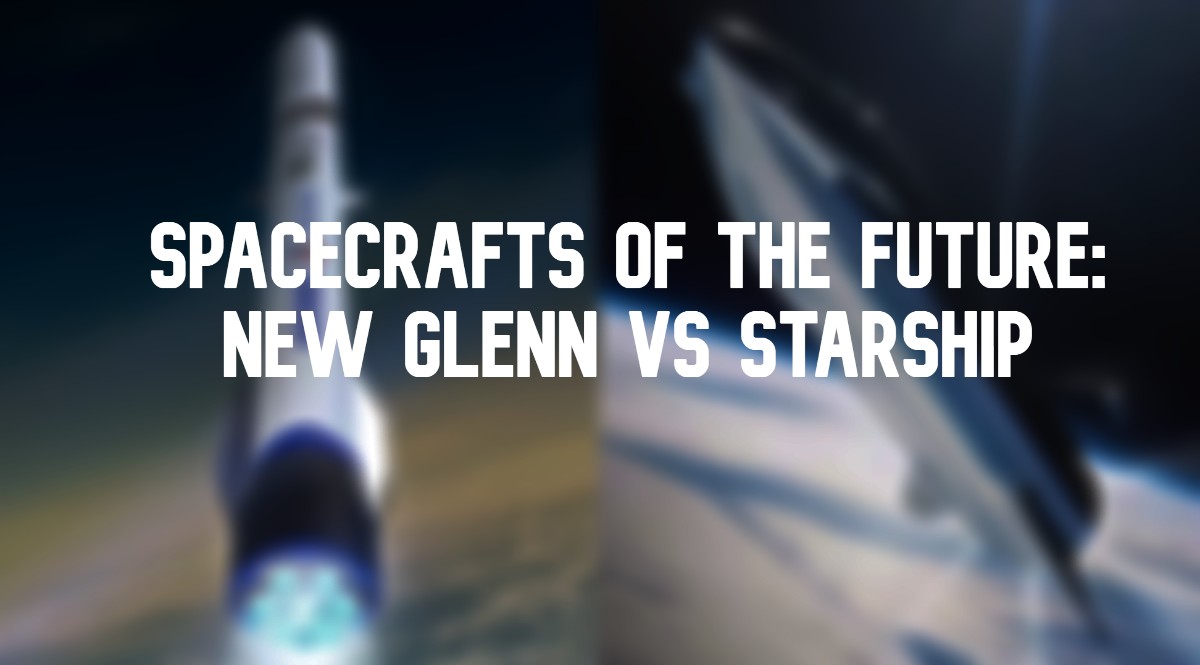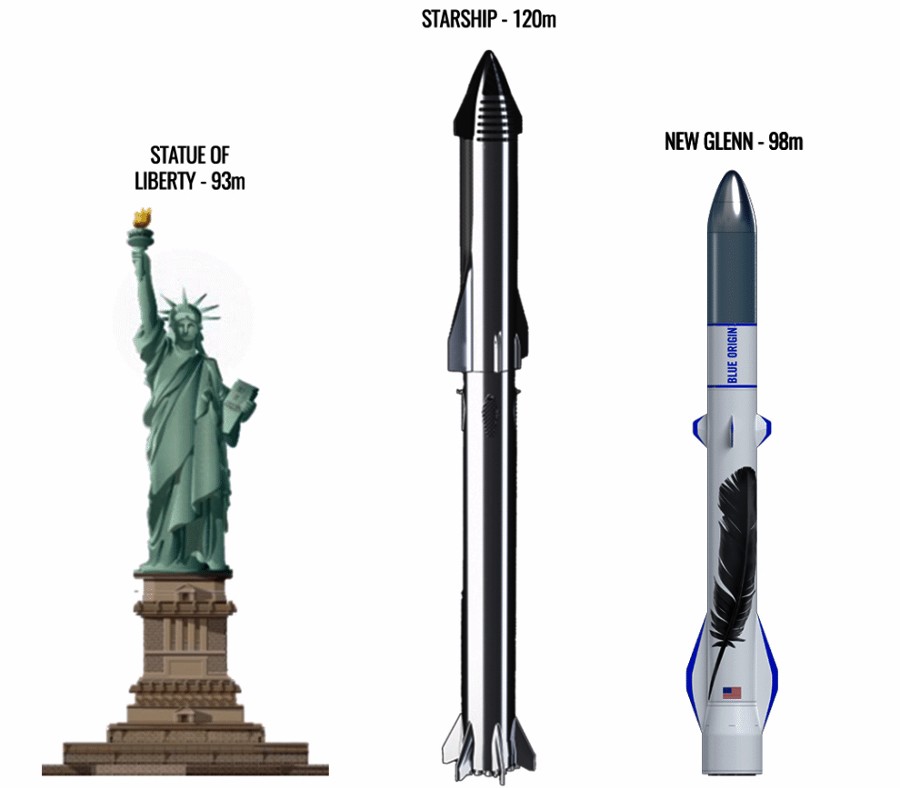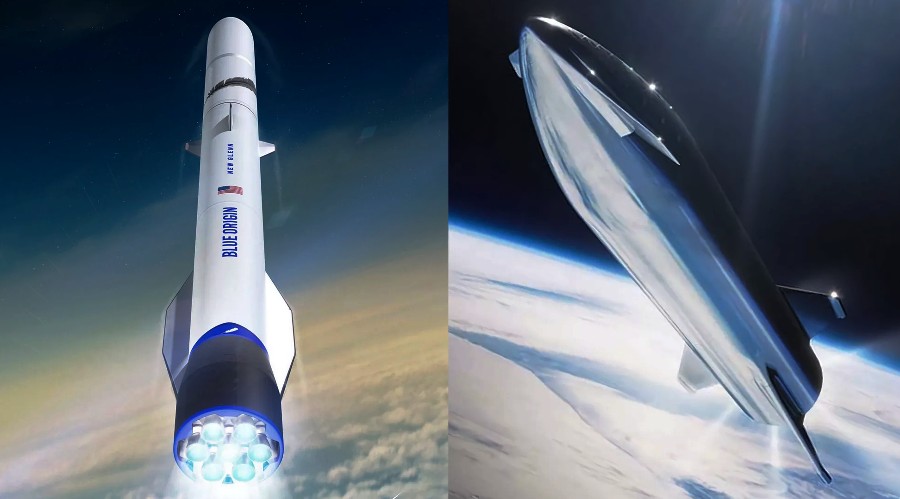Spacecrafts of the Future: New Glenn vs Starship
25th Jul 2022
In this article, we compare the rockets of the future. These are New Glenn and Starship, the heavy rockets built by leading private aerospace companies Blue Origin and SpaceX.
Space exploration is one of humanity’s most expensive and time-consuming activities. In the 20th century, one flight to Low Earth orbit cost taxpayers hundreds of millions of dollars, while the Apollo and Space Shuttle programs completely washed tens of billions out of the US budget, bringing in return only short-term satisfaction from defeating the USSR in the space race. However, this served as a good lesson, and already in the 21st century, the approach to space exploration was radically changed. The first private aerospace companies emerged, prioritizing the scientific and economic benefits of space research and replacement of expensive and outdated spacecraft with cheaper but more powerful and multipurpose rockets.
New Glenn vs Starship specs comparison
| Specifications | SpaceX Starship | Blue Origin New Glenn |
| Size (height, diameter) | 120 х 9 m | 98 х 7 m |
| Mass | 5,000 ton | 1,815 ton |
| Payload mass | 150 ton to LEO, 150 ton to GTO, Moon (with refuel) | 45 ton to LEO 13 ton to GTO |
| Capacity | 1,083.5 cubic м | 450 cubic м |
| Engines of 1 stage | Raptor 2 х 33 | BE-4 х 7 |
| Engines of the second stage | Raptor 2 х 6 | BE-3U х 2 |
| Reusability | Both stages | The first stage only |
| Production cost (till now)(USD) | 5 billion | 2.5 billion |
| Cost per launch, USD | 2 million | TBA |
| First commercial launch date | 2nd half of 2022 | 2023 |
Starship vs New Glenn: the battle for space
We already compared New Glenn and Neutron and also talked about Blue Origin vs. SpaceX competition before. As a quick reminder, let’s just say it lasts 20 years, and it is a struggle between two completely different approaches to space exploration. While SpaceX initially relied on the delivery of goods into orbit, Blue Origin chose space tourism. Eventually, both companies achieved impressive results, but it’s time to combine approaches to achieve more. This is how the projects of reusable space systems came to life. These systems can deliver cargo and astronauts not only to near-Earth orbits, but also to the Moon and Mars.
SpaceX first unveiled the Starship concept on 29th September 2017. The eccentric Elon Musk called his future brainchild BFR (Big Fucking Rocket), but a year later, the ship got a more acceptable name which reflected its essence better — Starship.
Blue Origin CEO Jeff Bezos sticks to more conservative names. He names his rockets after prominent astronauts, adding the prefix ‘New’. As you may have guessed, New Glenn was named after John Glenn, the first USA astronaut to orbit the Earth. Blue Origin publicly announced its intentions to build an orbital launch vehicle two years ahead of SpaceX, in September 2015.
And now, let’s try to determine the leader in this confrontation of New Glenn vs. Starship.
New Glenn vs. Starship: size comparison

The picture above shows that both rockets are bigger than the Statue of Liberty, but Starship is the biggest. It is 22 meters bigger than New Glenn and 27 meters bigger than the main US statue. In addition, the SpaceX ship is two meters wider than the Blue Origin rocket in diameter (9 versus 7). However, the Starship itself is only 50 meters high; the remaining 70 meters is the first stage of the Super Heavy (or, more simply, the SpaceX Falcon Heavy cargo rocket, but without side boosters and with different engines). At the same time, SpaceX assures that Starship will be able to fly not only in the basic modification (Starship + Super Heavy) but also in three other variants:
- Starship Cargo,
- Starship Lunar Lander,
- Starship Tanker (for refuelling in space or on other planets).
On the other hand, New Glenn can only offer a standard 2 or 3-stage modification with a payload fairing up to 22 m high.
Is Blue Origin’s New Glenn rocket more powerful than SpaceX’s BFR?

No. New Glenn will be able to carry 45 tons of payload to LEO and 13 tons to GTO. No doubt, this is more than most modern rockets can offer. But it is still 17 tons less than Falcon Heavy can carry. You ask why is New Glenn so much bigger than Falcon Heavy, but has less payload capacity? The answer is engines.
BFR vs New Glenn engine comparison
The Falcon Heavy’s payload advantage comes from two side-boosters and more powerful engines. The Falcon Heavy has a total of 27 Merlin 1D liquid engines (9 in each booster and 1 stage), developing thrust above sea level of 852 kN each. And what about New Glenn? The first stage of the New Glenn has seven BE-4 engines with a thrust of 2400 kN, and its second stage has two BE-3U engines with a thrust of 1100 kN. A simple addition tells us that the total thrust of the Falcon Heavy is 23,000 kN versus 19,000 kN for the New Glenn. But Starship surpasses them both! It is equipped with 39 Raptor 2 engines of 2000 kN thrust (33 in the first stage, 6 in the second), which allows it to handle a payload of up to 150 tons!
So is Starship the most powerful rocket?
The answer is obvious. Comparing Falcon Heavy, New Glenn rocket and BFR, the latter wins.
New Glenn vs. Starship: Reusability
Are Starship and New Glenn reusable? This is perhaps the most important metric after power and capacity, as it directly affects the final launch cost. Let’s agree, you will spend much less money on the production of a new rocket if you can reuse some of its parts. SpaceX promise that both stages of Starship will be reusable, while Blue Origin is more restrained in their statements. The company’s website states that the New Glenn will have a reusable first stage, but it will be reused up to 25 times. SpaceX do not brag about the number of re-launches; the latter speak for themselves. Falcon 9 launch statistics show that the company could use the same first stage 11 times!
What will fly first, Starship or New Glenn?
There is no definite answer to this question. But Starship obviously has higher odds, since the system has already been repeatedly tested. The Starship SN 15 Launch took place on 5th May 2022. The prototype successfully overcame an altitude of 10 kilometers and landed without any problems. And on 14th June Elon Musk tweeted that Starship would most likely make its first orbital flight in August 2022.
SpaceX’s indisputable success leaves little doubt in his words, but the same cannot be said about Blue Origin. The launch of the New Glenn rocket was originally scheduled for 2020, but was then delayed until the end of 2021. Early last year, Blue Origin said it was pushing back to the end of 2022. The explanation was deliberately simple: “We will fly when we’re ready.”
May the best rocket win
The space race has changed significantly in the 21st century. Now, players focus on speed, affordability, and reliability rather than the number of achievements. So far, SpaceX has the lead in the race of New Glenn vs Starship, but the competition never rests. After all, earning NASA’s trust means securing multibillion-dollar contracts for sending rockets to the Moon and Mars, along with international recognition of the company’s technical leadership. And that, without any doubt, is a major incentive.






Thank you for your comment! It will be visible on the site after moderation.